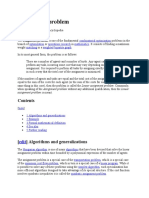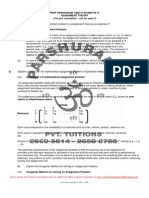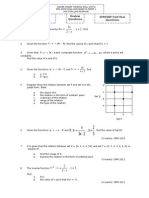Assignement Problem
Uploaded by
diveta.mishraAssignement Problem
Uploaded by
diveta.mishraASSIGNMENT PROBLEM
Classic assignment issue is a subset of linear programming problem. This is normally done
on a one-to-one basis. This paper offers an overview of the many aspects of the assignment
problem. Assignment issues require optimally matching the elements of two or more sets,
with the dimension of the problem denoting the number of sets of items to be matched. The
goal here is to detect these changes and make it easy for a researcher to create some version
of the assignment issue for a certain application.
Linear programming techniques may be utilised in assignment problems when available
resources, such as labour, machinery, and tools, must be allocated to various activities in the
most cost-effective or profit-maximizing manner.
The assignment issue is a well-structured linear programming problem in which the number
of jobs (tasks) equals the number of individuals (facilities). Thus, the problem's purpose is to
determine how the assignment should be done in order to accomplish the allocation. The
most renowned algorithm for the assignment problem is Kuhn's 'Hungarian Algorithm' 1. This
is named for Hungarian mathematician König, who discovered a necessary theorem for the
method's development in 1916. It is worth noting that the classic AP is mathematically similar
to the weighted bipartite matching issue from graph theory, and hence results from that
problem have been utilised to develop efficient solution strategies for the classic AP.
All classes of the assignment problem have the following characteristics: -
The overall objective is to minimize the cost of assigning tasks.
Binary decision variables are used to indicate when a task is completed.
Each task can only be assigned once.
Functions must be linear, or have the ability to be converted into a linear nature.
The assignment problem is a version of the transportation problem. The assignment problem
is a subset of the transportation problem that has two features. First, the problem's pay off
matrix would be square, and second, the best solution would always result in just one
assignment in a particular row or column of the pay off matrix. The goal is to allocate a
number of sources to an equal number of destinations while keeping costs to a minimum. For
example, assignees may be workers who need to be given job assignments. Assigning
individuals to occupations is a popular use of the assignment issue. However, assignees do
not have to be persons.
They also could be machines, or vehicles, or plants, or even time slots to be assigned tasks.
To fit the definition of an assignment problem, these kinds of applications need to be
formulated in a way that satisfies the following assumptions.
denoted by 𝑛).
(i) The number of assignees and the number of tasks are the same. (This number is
(ii) Each assignee is to be assigned to exactly one task.
1
H.W. Kuhn, The Hungarian method for the assignment problem, Naval research logistics
quarterly,2,8397, (1955)
There is a cost cij associated with assignee 𝑖 (𝑖 = 1, 2, . . . , 𝑛) performing task 𝑗(
(iii) Each task is to be performed by exactly one assignee.
𝑗= 1, 2, . . . , 𝑛).
(iv)
(v) The objective is to determine how all n assignments should be made to minimize
the total cost.
Application
Engineers utilise linear programming to tackle design and production issues. Engineers, for
example, aim to optimise the aerodynamic design of aerofoil meshes. This reduces the drag
coefficient of the aerofoil. Linear programming therefore gives engineers with a valuable tool
for form optimisation. The assignment problem is frequently used to help in many sorts of
timetable planning. This is because timetabling may easily be represented as a 0-1 assignment
of activities to resources. Kanjana Thongsanit2 wrote a research work titled Classroom
Assignment Problem for a University. The goal of the research is to create a mathematical
model and design strategies for solving the challenge. Excel's Premium Solver is used in this
investigation. It was discovered that Excel's Premium Solver can answer the classroom
allocation problem in seconds. The Assignment Problems may be used in agricultural
planning to allocate lands for different crops and distribute available resources such as
fertiliser, labour, water supply, and so on in order to maximise overall income.
2
Kanjana Thongsanit, Solving the Course - Classroom Assignment Problem for a
University, 2013.
You might also like
- Unit.3 Assignment Problem (By Dr. K.srinivas)No ratings yetUnit.3 Assignment Problem (By Dr. K.srinivas)41 pages
- A Least Cost Assignment Technique For Solving Assignment ProblemsNo ratings yetA Least Cost Assignment Technique For Solving Assignment Problems16 pages
- A Comparative Analysis of Assignment Problem: Shweta Singh, G.C. Dubey, Rajesh ShrivastavaNo ratings yetA Comparative Analysis of Assignment Problem: Shweta Singh, G.C. Dubey, Rajesh Shrivastava15 pages
- Unit - II: Assignment Problems Hungarian MethodNo ratings yetUnit - II: Assignment Problems Hungarian Method41 pages
- Assignment Problem: Hungarian Algorithm and Linear Programming Collected From The Internet and Edited by Longin Jan LateckiNo ratings yetAssignment Problem: Hungarian Algorithm and Linear Programming Collected From The Internet and Edited by Longin Jan Latecki26 pages
- University School of Business (MBA) : SUBJECT NAME: Decision Science-II Subject Code: 20bat652No ratings yetUniversity School of Business (MBA) : SUBJECT NAME: Decision Science-II Subject Code: 20bat6528 pages
- Ones Assignment Method For Solving Assignment Problems: Applied Mathematical Sciences, Vol. 6, 2012, No. 47, 2345 - 2355No ratings yetOnes Assignment Method For Solving Assignment Problems: Applied Mathematical Sciences, Vol. 6, 2012, No. 47, 2345 - 235511 pages
- Presentation By:-Shubham Gupta Sumit Malik Vishal GohanNo ratings yetPresentation By:-Shubham Gupta Sumit Malik Vishal Gohan41 pages
- An Application of Assignment Problem in Traveling Salesman Problem (TSP)No ratings yetAn Application of Assignment Problem in Traveling Salesman Problem (TSP)4 pages
- Assignment Problem: NOTE: The Pay Off Matrix of Assignment Problem Is A Square Matrix. ItNo ratings yetAssignment Problem: NOTE: The Pay Off Matrix of Assignment Problem Is A Square Matrix. It3 pages
- Assignment Problem in Operational ResearchNo ratings yetAssignment Problem in Operational Research4 pages
- The Assignment Problem: SMS 4674 / SMS 3392 Operational Research100% (2)The Assignment Problem: SMS 4674 / SMS 3392 Operational Research33 pages
- MCA Mathematical Foundation For Computer Application 15No ratings yetMCA Mathematical Foundation For Computer Application 1512 pages
- Computational Geometry: Exploring Geometric Insights for Computer VisionFrom EverandComputational Geometry: Exploring Geometric Insights for Computer VisionNo ratings yet
- Permutations by Cutting and Shuffling by SB MorrisNo ratings yetPermutations by Cutting and Shuffling by SB Morris74 pages
- Answer All Questions: 4 Semester - B.E. / B.Tech Second Internal Assessment: 28-02-13No ratings yetAnswer All Questions: 4 Semester - B.E. / B.Tech Second Internal Assessment: 28-02-131 page
- Decentralized Formation Control With Variable Shapes For Aerial RobotsNo ratings yetDecentralized Formation Control With Variable Shapes For Aerial Robots8 pages
- Crisostomo O. Retes National High School: General Mathematics Cycle 2No ratings yetCrisostomo O. Retes National High School: General Mathematics Cycle 215 pages
- Duality in Fundamentals of Operation ResearchNo ratings yetDuality in Fundamentals of Operation Research4 pages
- Nourdin I., Peccati G - Normal Approximations With Malliavin Calculus-Cambridge University PressNo ratings yetNourdin I., Peccati G - Normal Approximations With Malliavin Calculus-Cambridge University Press256 pages
- Mat201 Partial Differential Equations and Complex Analysis, December 2023No ratings yetMat201 Partial Differential Equations and Complex Analysis, December 20232 pages
- (L1) - (JEE 2.0) - Differential Equation - 4th DecNo ratings yet(L1) - (JEE 2.0) - Differential Equation - 4th Dec49 pages
- R5:Equations With Real Solutions.: 3wtw GNo ratings yetR5:Equations With Real Solutions.: 3wtw G7 pages
- 1 Functions, Limits and Continuity LagosNo ratings yet1 Functions, Limits and Continuity Lagos23 pages
- The 0/1 Knapsack Problem The 0/1 Knapsack ProblemNo ratings yetThe 0/1 Knapsack Problem The 0/1 Knapsack Problem21 pages
- Fundamental Trigonometric Identities SampleNo ratings yetFundamental Trigonometric Identities Sample7 pages
- HOTS Drill 1 Exercise Paper 1 Functions 2015100% (1)HOTS Drill 1 Exercise Paper 1 Functions 201513 pages

























































































